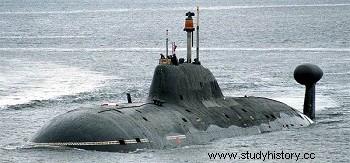
Project 971
History
Akoula (shark in Russian) is the NATO code for a Soviet nuclear attack submarine. The Russian name is “Project 971 Chtchouka B” (or Chtchouka meaning Esox or pike in Russian). The NATO classification (Akoula I, II, III) has no equivalent in Russia because the 971 projects all differ from each other. There are many differences between each sub-category (e.g. 971, 971M, 971U, 971A…).
The Akoula-class submarines were designed as a reaction to the American Los Angeles-class submarines. The Akoula class is a complete overhaul of the Alfa class (already well advanced for its time).
They can carry a wide choice of 38 weapons including explosive torpedoes (including the VA-111 Chkval), wake-detecting torpedoes, sea-to-sea missiles and mines as well as decoy torpedoes, using a sonic generator to imitate the sound of a submarine. All Akoula-class submarines were assigned to the Pacific Fleet until 1994. The Soviet Navy and then the Russian Navy ordered the construction of thirteen submarines of this class.
It is one of the most advanced submarines in the Russian Navy. In terms of sound emissions, it is said to be quieter than the Los Angeles-class submarines, at least at low speeds.
List of boats
Shipyard No. 199 in Komsomolsk-on-Amur
Name Commissioned
501 K-284 (Akoula) Shark December 30, 1984
502 K-263 (Deljfin) Dauphin December 30, 1987
513 K-322 (Kachalot)Cachalot December 30, 1988
514 K-391 (Kit ) Whale December 29, 1989
515 K-331 (Narwhal) Narwhal December 31, 1990
516 K-419 (Mors) Morse December 31, 1992
517 K-295 (Drakon) Dragon July 17, 1995
518 K-152 (Nerpa) Seal 2002
519 K-? n/a — —
520 K-? n / a — —
521 K-? n / a — —
Shipyard No. 402 in Severodvinsk
Name Translation Commissioning
821 K-480 (Ak Bars ) Snow Leopard December 29, 1989
822 K-317 (Pantera) Panther December 27, 1990
831 K-461 (Volk) Wolf December 29, 1991
832 K-328 (Leopard) Leopard December 30, 1992
833 K-154 (Tiger) Tiger December 29, 1993
834 K-157 (Veprj) Boar November 25, 1995
835 K-335 (Gepard) Cheetah December 04, 2001
836 K-337 (Kuguar) Cougar
837 K-333 (Risj) Lynx
The K-337 and K-333 were never completed, as well as the last three examples from the shipyard no. 199.
Crashes
On November 8, 2008 at 5:30 GMT, an accident aboard the K-152 Nerpa while undergoing trials in the Sea of Japan/East Sea before being loaned to the Indian Navy, caused the death of 20 people and injured 22. others, who are evacuated to the Primorsky Territory. The submarine itself returned on November 9, 2008 to this base of the Pacific Fleet, located in Bolshoi Kamen, 150 km from Vladivostok, accompanied by the rescue ship Saïany. The unexpected activation of the fire-fighting system and the release, according to some sources, of toxic trichlorofluoromethane (freon) is at the origin of the accident, the most important encountered by the Russian Navy since the sinking of the Kursk on August 12, 2000 According to the Russian authorities, the human factor is excluded, which some experts and veterans deny, arguing that the overcrowding on board the submersible (208 people with a gas mask instead of 73, including 127 technicians or inexperienced civilians emergency procedures) could have been a determining factor in the accident. The commission of inquiry finds the responsibility of a sailor, a member of the permanent crew of the submarine, suspected of having incorrectly adjusted the temperature sensor. He is charged with manslaughter. However, engineers who built the submarine indicate that the fire-fighting system is too complex to be triggered by mistake by a crew member and sailors blame the on-board computer, which would have already triggered unexpectedly at the factory. the fire-fighting system, such as faulty gas masks. Finally, the use of English in the software and instructions displayed on the fire-fighting system is mentioned as a factor in the accident. Finally, on November 25, 2008, we learned from the shipyards that the central control panel of the fire-fighting system was "poorly finished" and "has already experienced problems" and that the "Molibden-I" system for centralized control of the building itself "requires serious improvements". The sea trials of the Nerpa will continue until March 2009 at the latest with the same crew following the investigation and the necessary technical expertise. On December 29, 2011, she was officially handed over to India for a 10-year lease of $920 million.
Served in Soviet Navy Russian Navy Indian Navy
Technical characteristics
Type Nuclear attack submarine
Length 110.6 m
Maître-bau 13.6 m
Draft 10.4 m
Displacement 7,500 t (surface) 9,500 t (diving)
Propulsion 1 pressurized water reactor OK-650
Power 47,600 hp
Speed 28 knots
Military features
Armament 4 x 21 in tubes, 4 x 25.6 in tubes, 6 x 21 in outer tubes,
Missiles:S-10 Granat (SS-N-21), RPK-7 Vodopei (SS -N-16), 3M-54 Club
Other features
Crew 85 men
